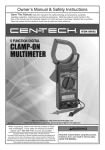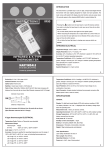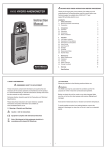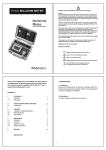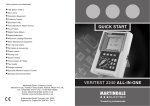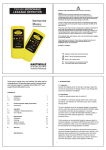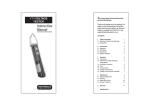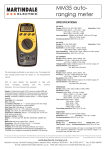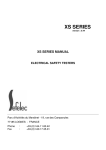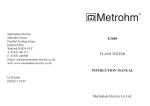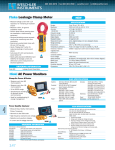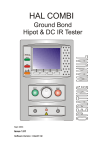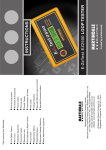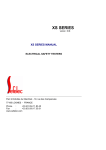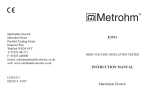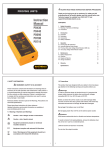Download Manual - Martindale Electric
Transcript
SAFETY INFORMATION: Always read before proceeding. WARNING CM54 CLAMP METER This manual contains both information and warnings that are necessary for the safe operation and maintenance of the clampmeter. It is recommended that you read the instructions carefully and ensure that the contents are fully understood. Failure to understand and to comply with the warnings and instructions can result in serious injury, damage or even death. INSTRUCTION MANUAL In order to avoid the danger of electrical shock, it is important that proper safety measures are taken when working with voltages exceeding 30V AC rms, 42V AC peak or 60V DC. The clampmeter must only be used under the conditions and for the purposes for which it has been constructed. Particular attention should be paid to these warnings, the precautions, the technical specifications and the use of the CM54 in dry surroundings. Always inspect your clampmeter, test leads and accessories for any sign of damage before use. If any abnormal conditions exist (e.g: broken test leads, cracked case, display not reading, etc.), do not attempt to use it. Do not expose it to direct sunlight, excessive temperature or moisture. Keep this instruction manual for future reference. Updated instructions and product information are available at: www.martindale-electric.co.uk SYMBOLS: Equipment complies with relevant EU Directives AC (Alternating Current) Ground Direct Current Equipment protected by Double Insulation (Class II) Caution - refer to accompanying documents MARTINDALE Caution - risk of electric shock End of life disposal of this equipment should be in accordance with relevant EU Directives ELECTRIC Trusted by professionals CONTENTS 1 1.1 1.2 1.3 Introduction Description Unpacking & Inspection Replacing the Battery 1. INTRODUCTION This manual contains information and warnings which must be followed to ensure safe operation of the clampmeter. 2 2 4 4 2 Safety Information 5 3 3.1 3.2 3.3 3.4 Operation Voltage Measurement Current Measurement Resistance Measurement Continuity Testing 5 5 6 7 8 4 4.1 4.2 4.3 Maintenance Cleaning Repair & Service Storage Conditions 9 9 9 9 5 Warranty 9 Technical Specification 10 WARNING READ "SAFETY INFORMATION" BEFORE USING THE METER 1.1 Description This clampmeter is a handheld 2000-count instrument that is designed for use in the laboratory, field servicing, and any circumstance where high current measurement is required. The clampmeter incorporates a finger guard which ensures the safety of the user whilst operating the instrument, a rugged case that is shock resistant and fire retardant, and electronic overload protection for all functions and ranges. In addition, a protective carrying case is included for protection of the meter whilst not in use. 8 7 9 5 6 4 3 1 2 1 2 1.2 Unpacking and Inspection 1. Volt - Input Terminal This is the positive input terminal for VOLT measurements. Connection is made to it using the red test lead. Before unpacking the clampmeter, examine the shipping carton for any sign of damage. Unpack and inspect the clampmeter and any associated leads for damage. If there is any damage then consult your distributor immediately. 2. COM - Common Terminal This is the negative (Ground) input terminal for all measurement modes except current. Connection is made to it using the black test lead. After removing your new Digital Clamp Meter (DCM) from its packaging, you should have the following items: 3. Ω Ohms input terminal This is the positive input terminal for resistance and continuity measurements. Connection is made to it using the red test lead. 1. Digital clampmeter 2. Test lead set (one black, one red) 3. 9-Volt battery (installed in meter) 4. Instruction manual 5. Protective carry case 4. Display The display indicates the measured value of signal, function mode, low battery, range, max & hold settings. If any of the above items are missing or are received damaged, please contact the distributor from whom you purchased the unit. 5. Function / Range selector rotary switch. The rotary switch selects the function and desired range. 1.3 REPLACING THE BATTERY 6. Max - Maximum recording mode This function is used to measure the maximum value of AC/DC voltage, AC/DC current and resistance. WARNING To avoid electrical shock, disconnect the test leads and any input signals before replacing the battery. Replace only with same type of battery. 7. Hold Button Freezes the last reading displayed. 8. Clamp Jaws Detect AC current flowing through the conductor on test. This meter is powered by a NEDA type 1604 or equivalent 9-volt battery. When the meter shows the " " sign the battery must be replaced to maintain proper operation. Follow the procedure below to replace the battery. 9. Trigger Press the lever to open the clamp jaws. When the lever is released, the jaws will close. 1. Disconnect the test leads from any live source, turn the rotary switch to off and remove the test leads from the input terminals. 2. The battery cover is secured to the bottom case by a screw. Using a Phillips head screwdriver, remove the screw and then remove the battery cover. 3. Replace the battery with a new equivalent 9-volt one observing correct polarity. 4. Replace the battery cover and re-install the screw. 3 4 2. SAFETY INFORMATION 4. Plug the red test lead into the VOLT input jack on the meter and connect to the circuit where a voltage measurement is required. Voltage is always measured in parallel across a test point. The instrument complies with class II overvoltage CAT III 1000V of the IEC1010-1 (EN61010-1) ; UL3111-1; and CAN/CSA C22.2 #1010.1-92 standards, pollution degree 2 in accordance with IEC-664 indoor use. If the equipment is used in a manner not specified, the protection provided by the equipment may be impaired. 5. Energise the circuit or device under test and make the voltage measurements. Reduce the range setting, if set too high, until a satisfactory best resolution reading is obtained. This product complies with the requirements of the following European Community Directives: 89/336/EEC (Electromagnetic Compatibility) and 73/23/EEC (Low Voltage) as amended by 93/68/EEC (CE Marking). 6. After completing the measurement, turn off the power to the circuit / device under test, discharge all capacitors and disconnect the meter test leads. Electrical noise or intense electromagnetic fields in the vicinity of the equipment may disturb the measurement circuit. Measuring instruments will also respond to unwanted signals that may be present within the measurement circuit. Users should exercise care and take appropriate precautions to avoid misleading results when taking measurements in the presence of electromagnetic interference. 3.2 CURRENT MEASUREMENTS WARNING The clamp jaws are designed to take current measurements on circuits with a maximum voltage difference of 500VAC between any conductor and ground potential. Using the clamp jaws for current measurements on circuits above this voltage may cause electric shock, instrument damage and / or damage to the equipment under test. Before measuring current, make sure that the test leads are removed from the instrument. 3. OPERATION 3.1 VOLTAGE MEASUREMENTS 1. Turn off power to the circuit/device under test and discharge all capacitors. The clamp jaws are overload protected up to 500VAC for up to 1 minute. Do not take current readings on circuits where the maximum current potential is not known. Do not exceed the maximum current that the instrument is designed to measure. 2. Plug the black test lead into the COM input jack on the meter and connect the test lead tip to a grounded point (the reference point for measured voltage). 3. Select the desired AC voltage range (V ), or DC voltage range (V ). If the magnitude of the voltage to be measured is unknown, always start with the highest range. 1. Set function switch to ACA 1000A range. WARNING 2. Press the trigger to open the clamp jaws and clamp them around a conductor. The jaws should be completely closed before taking a reading. To avoid possible electric shock, instrument damage and / or equipment damage, do not attempt to take any voltage measurements if the voltage is above 1000V DC or 750VAC. These are the maximum voltages that this instrument is designed to measure. The "COM" terminal potential should not exceed 500V measured to ground. 3. The most accurate reading will be obtained by keeping the conductor across the centre of the clamp jaws. 5 6 4. The reading will be indicated on the display. 4. Connect the black & red test probe tips to the circuit or device under test, making sure it is de-energised first. 5. Reduce the range if set too high until a satisfactory best resolution reading is obtained. 5. Open circuits will be displayed as an overload condition. 6. Test lead resistance can affect low resistance measurements and should be subtracted from resistance measurements for accuracy. Select the lowest resistance range and short the test leads together. The value displayed is the test lead resistance, which should subtracted from the resistance measurement. Max - Maximum recording mode This function is used to measure the maximum value of AC/DC voltage, AC/DC current and resistance. To use this function, select the function and range then press the MAX button. When this is done the "MAX" indicator will appear on the display. When the instrument detects a signal, the maximum "MAX" value will be displayed and held in the internal memory. To cancel the function, press the MAX button once again. 7. After completing the measurement, disconnect the test leads. Note when using 2000MΩ Range The 2000MΩ range has a fixed 10-count offset in the reading. When the test leads are shorted together in this range, the meter will display 010. This residual reading must be subtracted from the measured resistance when this range is used. For example, when measuring 1500MΩ on the 2000MΩ range, the display will read 1510, from which the residual reading of 10 must be subtracted to obtain the actual resistance of 1500MΩ. Hold Button Press (HOLD) to toggle in and out of data hold mode. In the data hold mode, the "HOLD" indicator is displayed and the last reading is frozen on the display. Press the (HOLD) button again to exit and resume taking readings. 3.3 RESISTANCE MEASUREMENTS 3.4 CONTINUITY TESTING WARNING Attempting resistance or continuity measurements on live circuits can cause electrical shock, damage to the instrument and damage to the equipment under test. Resistance measurements must be made on de-energised (DEAD) circuits only, for maximum personal safety. The electronic overload protection installed in this instrument will reduce the possibility of damage to the instrument but not necessarily avoid all damage or shock hazards. 1. Select the ( ) position by turning the rotary selector switch. 2. Follow steps 2 & 4 as for resistance measurements 3. The clampmeter emits a tone when measuring resistance of approximately 75Ω or less. After measurements have been carried out, disconnect the test leads from the circuit and from the input terminals of the clampmeter. 1. Isolate any power which may be present at the resistance to be measured and discharge any capacitors. Any voltage that may be present during a resistance measurement will cause inaccurate readings and could damage the meter if the voltage exceeds the overload protection of 500V DC or AC. 2. Insert the black & red test leads into the COM and Ω input terminals respectively. 3. Select the desired ohms (Ω) range. 7 8 4. MAINTENANCE Specification CM54 Clamp Meter Maintenance consists of periodic cleaning and battery replacement. Repairs or servicing not covered in this manual should only be performed by qualified personnel. 4.1 Cleaning The CM54 may be cleaned using a soft dry cloth. Do not use abrasives, solvents, or detergents, which can be conductive. 4.2 Repair & Service There are no user serviceable parts in this unit. Return to Martindale Electric Company Ltd if faulty. Our service department will quote promptly to repair any fault that occurs outside the guarantee period. Display: 3½ digit 21mm large LCD, maximum reading 1999 with function and units sign annunciators. Polarity: Automatic, positive implied, negative indicated. Before the unit is returned, please ensure that you have checked the unit and associated leads thoroughly for flat batteries (check & replace), blown fuses (check & replace) and other poor connections. Over Range Indication: (OL) is displayed. 4.3 Storage Conditions The clampmeter should be kept in warm dry conditions away from direct sources of heat or sunlight, and in such a manner as to preserve the working life of the unit. It is strongly advised that the unit is not kept in a tool box where other tools may damage it. Low Battery Indication: The " below accurate operating level. " is displayed when the battery voltage drops Display Update Rate: 2.5 per second, nominal Operating Environment: 0°C to 50°C at <70% Relative Humidity. Storage Environment: -20°C to 60°C at <80% Relative Humidity with battery removed from meter. 5. WARRANTY The CM54 is guaranteed against faults in manufacture and materials for 24 months from date of invoice and will be rectified by us free of charge, provided the unit has not been tampered with and is returned to us with its housing unopened. Damage due to dropping, abuse or misuse is not covered by this guarantee. Batteries and fuses are not covered by this guarantee. Temperature Coefficient: 0.1 X (specified accuracy) / °C (<18°C or >28°C) Altitude: 2000M max Power: Standard 9-volt battery, NEDA 1604, IEC 6F22, JIS 006P, PP3 Battery Life: 300 hours typical with alkaline battery. Jaw Opening Capability: 57mm conductor, 70 X 18mm bus bar. Size (H x W x D): 189 x 87 x 37mm Weight: Approx. 540grams (including battery) * Accuracy is given as ± ([% of reading]+[number of least significant digits]) at 18°C to 28°C with relative humidity up to 70%. 9 Continuity Test Other products from Martindale: Audible Threshold Open Circuit Volts Response Time G 16th Edition Testers G Non-trip Loop Testers G All-in-one’s G PAT Testers & accessories G Calibration Equipment G Phase Rotation Units G Continuity Testers G Proving Units G Electrician’s Kits G Socket Testers G Full Calibration & Repair Service G Thermometers & Probes G Fuse Finders G Test Leads G Digital Clamp Meters G Voltage Indicators Overload protection: 1000VDC / 750V AC RMS G Digital Multimeters G Specialist Metrohm Testers (4 & 5kV) AC Volts (Average sensing RMS indicating) G Microwave Leakage Detectors G Specialist Drummond Testers Less than 75Ω ~ ~500msec 3.0Vdc typical Overload Protection: 500v DC or AC rms DC Volts Range 1000V Resolution 1V Accuracy ±(0.5% rdg +1d) Input Impedance 10MΩ Range Resolution Accuracy Input Impedance 750V 1V ±(1.5% rdg +4d) 4.5MΩ G Motor Maintenance Equipment Frequency Response: 50Hz to 500Hz Overload protection: 1000VDC or 750V AC RMS AC Current (Average sensing RMS indicating) Range Resolution 200A 100mA 1000A 1A Accuracy 0-600A±(1.5% rdg+5d)50-60Hz >600A±(2.0% rdg+5d)50-60Hz 0-600A±(3.0%rdg+5d)61-400Hz >600A±(3.5%rdg+5d)61-400Hz Overload Protection: 1200A for 60 seconds Maximum Resistance Range Resolution Accuracy Open Circuit Volts 200Ω 20kΩ 20MΩ 2000MΩ 0.1Ω 10Ω 10kΩ 1000kΩ ±(1.2% rdg+4d) ±(1.0% rdg+3d) ±(2.0% rdg+5d) ±(5% rdg+10d) 3.0Vdc 0.3Vdc 0.3Vdc 3.0Vdc Overload Protection: 500v DC or AC RMS Martindale Electric Company Limited Metrohm House, Penfold Trading Estate, Imperial Way, Watford, WD24 4YY, UK. Tel: +44(0)1923 441717 Fax: +44 (0)1923 446900 E-mail: [email protected] Website: www.martindale-electric.co.uk © Martindale Electric Company Ltd. 1997 - 2006 Registered in England No. 3387451. Rev 4




